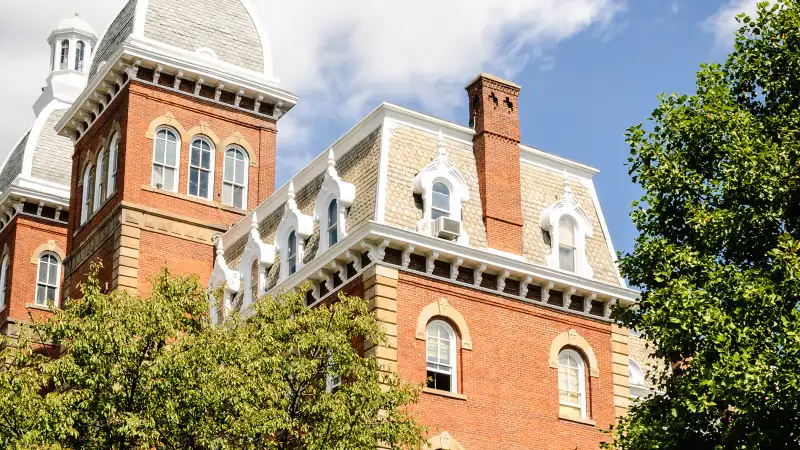The 20 Best Colleges You Can Still Get Into for the Fall

For this year's list of colleges that still have space, head here.
The Class of 2019 will descend on college campuses for the start of fall classes in just over three months. But for students who are uncertain of their plans, it’s not too late to apply to several quality schools.
More than 220 colleges have space for freshman or transfer students for the upcoming fall semester, according to the annual College Openings Update published today by the National Association for College Admission Counseling.
The list is released following the May 1 national response deadline, when many institutions require deposits from students who have been offered acceptance. After tallying the numbers to see whether they met enrollment goals, colleges with space available can volunteer to be included on the counseling association’s list. It’s available online until June 30.
Many of the colleges willing to accept late applications are some of the best schools in the country.
Reed College, an elite private liberal arts college in Oregon, has an especially good track record of helping its graduates move into top graduate schools. (Reed isn't included in Money's rankings of the best value colleges because it declines to provide sufficient data.)
Here are 20 colleges Money ranks as excellent values that are still accepting applications.
| College | State | Public or private? | Money Best Colleges rank | Graduation rate | PayScale.com avg. early career earnings |
|---|---|---|---|---|---|
| University of Washington Bothell | WA | Public | 37 | 64% | $52,100 |
| Holy Family University | PA | Private | 68 | 62% | $49,400 |
| Oregon Institute of Technology | OR | Public | 76 | 48% | $57,000 |
| Michigan Technological University | MI | Public | 82 | 66% | $59,200 |
| Illinois Institute of Technology | IL | Private | 92 | 68% | $55,000 |
| University of Arizona | AZ | Public | 99 | 61% | $48,400 |
| Wheaton College | MA | Private | 101 | 90% | $42,400 |
| New College of Florida | FL | Public | 134 | 69% | $39,800 |
| DePauw University | IN | Private | 134 | 78% | $46,600 |
| University of Northern Iowa | IA | Public | 138 | 66% | $40,600 |
| Washington State University | WA | Public | 138 | 67% | $45,900 |
| Loyola University Maryland | MD | Private | 138 | 84% | $51,000 |
| William Jewell College | MO | Private | 156 | 69% | $45,700 |
| Union College | KY | Private | 166 | 83% | $49,000 |
| Saint Joseph's University | PA | Private | 169 | 79% | $49,300 |
| University of Toledo | OH | Public | 173 | 46% | $44,900 |
| Ursuline College | OH | Private | 173 | 52% | $50,900 |
| Rockhurst University | MO | Private | 177 | 69% | $49,000 |
| The University of Tulsa | OK | Private | 194 | 66% | $55,000 |
| Wagner College | NY | Private | 208 | 66% | $48,200 |
May 1 is an important date in terms of planning for colleges and families, enrollment experts say. But just five years ago, the response deadline was much more absolute than it is now, says Sarah Coen, senior vice president at Ruffalo Noel Levitz, an enrollment consulting firm.
The shift is partially due to increased pressure on college enrollment teams in regions, such as the Northeast, where the number of high school graduates is flat or declining, Coen says. Competition for students, especially at tuition-dependent private colleges, is fierce.
That’s good news for families who haven’t solidified college plans, because it means a lot of decent colleges still actively seeking students.
Private institutions make up about 65% of the list, but there are also some large, flagship state universities that are still accepting applications, such as the University of Arizona, University of Oregon, and University of Florida. There are colleges in 42 states and the District of Columbia.
Washington & Jefferson College in Pennsylvania has been on the list for six of the past seven years. The 1,400-student private university has about 10 to 20 spots left to fill and can offer both financial aid and housing, says vice president of enrollment Robert Gould.
Students thinking about applying to a college in late May or June should be sure they take all the traditional steps to vet a college, including campus visits if possible, Gould says. But because of the late time, families also should be prepared to move fast. What’s generally an 18-month timeline will need to be whittled down to a matter of weeks or even days. And getting required items, such as transcripts or letters of recommendation, can be more challenging over the summer months.
Because of those demands, Washington & Jefferson's admissions director works individually with late-applying students. "You’re really condensing a lot, and any school that isn’t willing to give them that attention in a concentrated fashion probably isn’t going to be the best option for a family,” Gould says.
Most of the colleges on the list have spots in on-campus housing available, and all but four colleges said they have financial aid available.
Much of the list is made up of colleges with rolling admissions policies, meaning they accept students at any time until their class is filled. Likewise, they usually hand out financial aid until it's gone, says Peter Van Buskirk, a former dean of admissions and author of Winning the College Admissions Game: Strategies for Parents & Students.
So even if a college says it has financial aid available, families may find that the package offered for next year is light on grants and scholarships and heavy on loans and work study, Van Buskirk says. "Those who arrive late to the game are most likely to get what's left over," he adds.
The federal deadline for the free application for federal student aid (FAFSA) for aid for the fall semester isn’t until June 30, 2016, but at least 12 states have deadlines earlier this spring, according to Edvisors.com, which offers advice on college financial aid. Coen, the enrollment consultant, recommends families apply for FAFSA as soon as possible no matter what their state deadline is.
Keep in mind that this list of colleges still accepting students isn’t exhaustive. In addition to being voluntary, it’s comprised only of the 1,300 four-year colleges that are members of the counseling association. Community colleges—which accept students year-round—are largely excluded from the list.
And even if an institution isn’t included, that doesn’t necessarily mean they won’t be receptive to late applicants. Coen says that if students are interested in a certain college, they should contact the admissions office regardless of whether the college is advertising open space.
College admissions is a buyers market right now, she says.“If you’re a student they want for whatever reason, they’re going to do what they can to get you.”
See all of Money's Best Colleges

